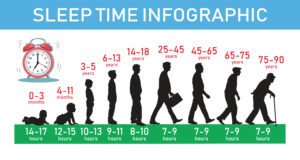We’ve all been there- you can barely keep your eyes open all day, but then suddenly when it’s time to get ready for bed you are wide awake and feeling wired. Or maybe you’re a parent and you’ve finally finished all the evening chores, baths are done, teeth brushed….and now the kids are bouncing off the walls. Last week we talked about four of the most common causes of sleep problems and reviewed some reasons you or your child might not be sleepy at bedtime, this week let’s talk about how to fix this frustrating sleep problem! A good, healthy sleeper should generally fall asleep within 10-15 minutes of getting into bed, so let’s figure out how to get you there!
Solution 1: Make sure you know how much sleep your child needs
As children grow, their sleep needs evolve. You might be surprised to learn that there is actually a very specific amount of sleep that individuals need at different ages, and while there is a small amount of variance within each age group, research has shown that we can predict exactly how much sleep people need at each age to function at their best. It’s important to be aware of the sleep recommendations for each age group and make sure your child is getting enough shut-eye (and if you are 18 or older make sure you get 7-9 hours). Use the chart below to figure out how much sleep your child needs.

Solution 2: Keep a Consistent Sleep Schedule
Maintaining a consistent sleep schedule plays a critical role in promoting healthy sleep for both kids and adults. A consistent sleep schedule means going to bed and waking up at the same times every day, with minimal variation- usually no more than 30 minutes on either end. Yes, this includes weekends, holidays, vacations, etc. (I know, I know… not what most people want to hear). I always tell clients that if you only make one change to your lifestyle for better sleep, hands down the best change to make is keeping a consistent sleep schedule. It may be hard to stick to at first but believe me, your body and brain will thank you.
Consistency in your sleep schedule offers both biological and behavioral benefits. Biologically, a consistent sleep schedule helps regulate the circadian rhythm, the internal clock that controls our sleep-wake cycle. It also aids in the natural production of melatonin, the hormone that promotes sleep. From a behavioral perspective, a consistent sleep schedule can help parents set clear expectations and makes it easier to establish and follow a routine. Children, in particular, thrive on predictability and structure so having a set bedtime and wake time every day and night will help decrease bedtime battles.
Solution 3: Use Bedtime Fading
If your sleep schedule isn’t currently where you want it to be, you can use a strategy called bedtime fading to slowly shift your circadian rhythm to your desired schedule. Bedtime fading is a gradual approach to adjusting your sleep schedule that works with your body’s natural tendencies. This technique is especially useful when you or your child are currently falling asleep too late and not getting enough sleep. Here’s how we use bedtime fading in a nutshell:
- Keep Track of When You/Your Child Is Currently Falling Asleep
Start by collecting at least a week’s worth of data on when you or your child fall asleep. It’s ok to estimate, but we want to know the approximate time of sleep onset. Note, that might be very different than the time you or your child gets into bed. The important number to write down each night is the time that you or your child actually falls asleep for the night. After about a week, figure out the average sleep onset time.
- Start With a Bedtime 30 Minutes Later Than the Average Sleep Onset Time
Using the average sleep onset time as a reference, we will start with a bedtime that is 30-60 minutes later. Yep, you read that right, we are going to start by going to bed EVEN LATER than the time you or your child is currently falling asleep. Why is that? Well, we want to capitalize on what we call “sleep pressure” meaning that we want to only get into bed when we are really sleepy and likely to fall asleep quickly. Generally speaking, it’s good practice to only get into bed when you are sleepy and likely to fall asleep fast and to get out of bed if you aren’t sleepy. We want to teach our body to associate the bed with sleep and falling asleep quickly, so we don’t want to practice laying in bed awake.
- Observe the Results and Adjust Slowly
If you or your child falls asleep within 15 minutes of getting into bed with the new later bedtime, we consider that a successful night. However, if it takes longer than 15 minutes to fall asleep, you may need to shift the bedtime even later. If we have two successful nights at the current bedtime, we can gradually start moving the bedtime 15 minutes earlier (never move it earlier by more than that!) until we reach our desired bedtime. While you are going through the bedtime fading process, it’s a good idea to keep a consistent wake-up time, and I usually recommend just sticking with your goal wake-up time even if it means a few nights of getting less sleep.
By implementing these three solutions, you’ll be quickly on your way to becoming a good, healthy sleeper that nods off quickly and gets the correct amount of sleep. But remember, you don’t have to go it alone! If you are struggling with sleep and need some help implementing these and other strategies, contact me or another sleep professional. And stay tuned for next week’s post, when we talk about how to fix chaos before bed!